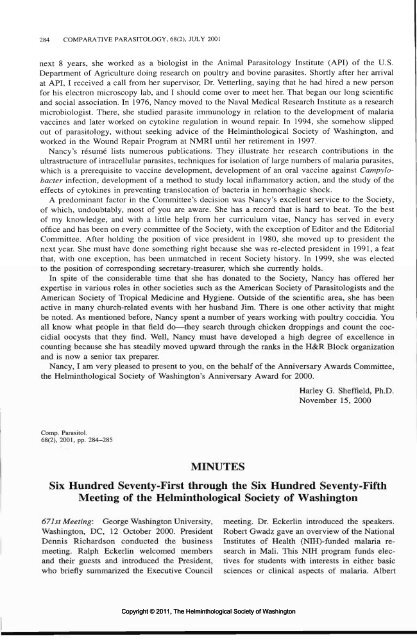Comparative Parasitology 68(2) 2001 - Peru State College
Comparative Parasitology 68(2) 2001 - Peru State College
Comparative Parasitology 68(2) 2001 - Peru State College
You also want an ePaper? Increase the reach of your titles
YUMPU automatically turns print PDFs into web optimized ePapers that Google loves.
284 COMPARATIVE PARASITOLOGY, <strong>68</strong>(2), JULY <strong>2001</strong><br />
next 8 years, she worked as a biologist in the Animal <strong>Parasitology</strong> Institute (API) of the U.S.<br />
Department of Agriculture doing research on poultry and bovine parasites. Shortly after her arrival<br />
at API, I received a call from her supervisor, Dr. Vetterling, saying that he had hired a new person<br />
for his electron microscopy lab, and I should come over to meet her. That began our long scientific<br />
and social association. In 1976, Nancy moved to the Naval Medical Research Institute as a research<br />
microbiologist. There, she studied parasite immunology in relation to the development of malaria<br />
vaccines and later worked on cytokine regulation in wound repair. In 1994, she somehow slipped<br />
out of parasitology, without seeking advice of the Helminthological Society of Washington, and<br />
worked in the Wound Repair Program at NMRI until her retirement in 1997.<br />
Nancy's resume lists numerous publications. They illustrate her research contributions in the<br />
ultrastructure of intracellular parasites, techniques for isolation of large numbers of malaria parasites,<br />
which is a prerequisite to vaccine development, development of an oral vaccine against Campylobacter<br />
infection, development of a method to study local inflammatory action, and the study of the<br />
effects of cytokines in preventing translocation of bacteria in hemorrhagic shock.<br />
A predominant factor in the Committee's decision was Nancy's excellent service to the Society,<br />
of which, undoubtably, most of you are aware. She has a record that is hard to beat. To the best<br />
of my knowledge, and with a little help from her curriculum vitae, Nancy has served in every<br />
office and has been on every committee of the Society, with the exception of Editor and the Editorial<br />
Committee. After holding the position of vice president in 1980, she moved up to president the<br />
next year. She must have done something right because she was re-elected president in 1991, a feat<br />
that, with one exception, has been unmatched in recent Society history. In 1999, she was elected<br />
to the position of corresponding secretary-treasurer, which she currently holds.<br />
In spite of the considerable time that she has donated to the Society, Nancy has offered her<br />
expertise in various roles in other societies such as the American Society of Parasitologists and the<br />
American Society of Tropical Medicine and Hygiene. Outside of the scientific area, she has been<br />
active in many church-related events with her husband Jim. There is one other activity that might<br />
be noted. As mentioned before, Nancy spent a number of years working with poultry coccidia. You<br />
all know what people in that field do—they search through chicken droppings and count the coccidial<br />
oocysts that they find. Well, Nancy must have developed a high degree of excellence in<br />
counting because she has steadily moved upward through the ranks in the H&R Block organization<br />
and is now a senior tax preparer.<br />
Nancy, I am very pleased to present to you, on the behalf of the Anniversary Awards Committee,<br />
the Helminthological Society of Washington's Anniversary Award for 2000.<br />
Comp. Parasitol.<br />
<strong>68</strong>(2), <strong>2001</strong>, pp. 284-285<br />
MINUTES<br />
Harley G. Sheffield, Ph.D.<br />
November 15, 2000<br />
Six Hundred Seventy-First through the Six Hundred Seventy-Fifth<br />
Meeting of the Helminthological Society of Washington<br />
671st Meeting: George Washington University, meeting. Dr. Eckerlin introduced the speakers.<br />
Washington, DC, 12 October 2000. President Robert Gwadz gave an overview of the National<br />
Dennis Richardson conducted the business Institutes of Health (NIH)-funded malaria remeeting.<br />
Ralph Eckerlin welcomed members search in Mali. This NIH program funds elecand<br />
their guests and introduced the President, lives for students with interests in either basic<br />
who briefly summarized the Executive Council sciences or clinical aspects of malaria. Albert<br />
Copyright © 2011, The Helminthological Society of Washington
















